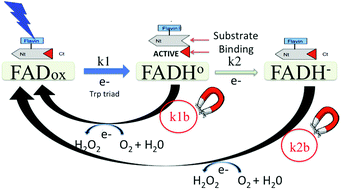当前位置:
X-MOL 学术
›
Photochem. Photobiol. Sci.
›
论文详情
Our official English website, www.x-mol.net, welcomes your
feedback! (Note: you will need to create a separate account there.)
Cryptochrome mediated magnetic sensitivity in Arabidopsis occurs independently of light-induced electron transfer to the flavin.
Photochemical & Photobiological Sciences ( IF 2.7 ) Pub Date : 2020-02-17 , DOI: 10.1039/c9pp00469f M Hammad 1, 2 , M Albaqami 1, 2 , M Pooam 1 , E Kernevez 1 , J Witczak 1 , T Ritz 3 , C Martino 2 , M Ahmad 1, 4
Photochemical & Photobiological Sciences ( IF 2.7 ) Pub Date : 2020-02-17 , DOI: 10.1039/c9pp00469f M Hammad 1, 2 , M Albaqami 1, 2 , M Pooam 1 , E Kernevez 1 , J Witczak 1 , T Ritz 3 , C Martino 2 , M Ahmad 1, 4
Affiliation

|
Cryptochromes are highly conserved blue light-absorbing flavoproteins which function as photoreceptors during plant development and in the entrainment of the circadian clock in animals. They have been linked to perception of electromagnetic fields in many organisms including plants, flies, and humans. The mechanism of magnetic field perception by cryptochromes is suggested to occur by the so-called radical pair mechanism, whereby the electron spins of radical pairs formed in the course of cryptochrome activation can be manipulated by external magnetic fields. However, the identity of the magnetosensitive step and of the magnetically sensitive radical pairs remains a matter of debate. Here we investigate the effect of a static magnetic field of 500 μT (10× earth's magnetic field) which was applied in the course of a series of iterated 5 min blue light/10 min dark pulses. Under the identical pulsed light conditions, cryptochrome responses were enhanced by a magnetic field even when exposure was provided exclusively in the 10 min dark intervals. However, when the magnetic stimulus was given exclusively during the 5 min light interval, no magnetic sensitivity could be detected. This result eliminates the possibility that magnetic field sensitivity could occur during forward electron transfer to the flavin in the course of the cryptochrome photocycle. By contrast, radical pair formation during cryptochrome flavin reoxidation would occur independently of light, and continue for minutes after the cessation of illumination. Our results therefore provide evidence that a magnetically sensitive reaction is entwined with dark-state processes following the cryptochrome photoreduction step.
中文翻译:

拟南芥中隐花色素介导的磁敏性独立于光诱导的电子转移至黄素而发生。
隐色染料是高度保守的吸收蓝光的黄素蛋白,其在植物发育过程中以及在动物的生物钟的携带过程中充当感光器。它们已与许多生物体(包括植物,果蝇和人类)对电磁场的感知有关。建议通过隐色染料感知磁场的机理是通过所谓的自由基对机理发生的,由此在隐色染料活化过程中形成的自由基对的电子自旋可以通过外部磁场来操纵。然而,磁敏台阶和磁敏自由基对的身份仍然是一个争论的问题。在这里,我们研究了500μT(10×地球 磁场)施加于一系列5分钟的蓝光/ 10分钟的暗脉冲重复过程中。在相同的脉冲光条件下,即使仅在10分钟的黑暗间隔内进行曝光,磁场也会增强隐色反应。但是,如果仅在5分钟的光照间隔内给予磁刺激,则无法检测到磁敏感性。该结果消除了在隐色光循环过程中正向电子转移至黄素的过程中可能发生磁场敏感性的可能性。相比之下,隐色黄素再氧化期间自由基对的形成将独立于光而发生,并且在停止照明后持续几分钟。
更新日期:2020-03-19
中文翻译:

拟南芥中隐花色素介导的磁敏性独立于光诱导的电子转移至黄素而发生。
隐色染料是高度保守的吸收蓝光的黄素蛋白,其在植物发育过程中以及在动物的生物钟的携带过程中充当感光器。它们已与许多生物体(包括植物,果蝇和人类)对电磁场的感知有关。建议通过隐色染料感知磁场的机理是通过所谓的自由基对机理发生的,由此在隐色染料活化过程中形成的自由基对的电子自旋可以通过外部磁场来操纵。然而,磁敏台阶和磁敏自由基对的身份仍然是一个争论的问题。在这里,我们研究了500μT(10×地球 磁场)施加于一系列5分钟的蓝光/ 10分钟的暗脉冲重复过程中。在相同的脉冲光条件下,即使仅在10分钟的黑暗间隔内进行曝光,磁场也会增强隐色反应。但是,如果仅在5分钟的光照间隔内给予磁刺激,则无法检测到磁敏感性。该结果消除了在隐色光循环过程中正向电子转移至黄素的过程中可能发生磁场敏感性的可能性。相比之下,隐色黄素再氧化期间自由基对的形成将独立于光而发生,并且在停止照明后持续几分钟。











































 京公网安备 11010802027423号
京公网安备 11010802027423号